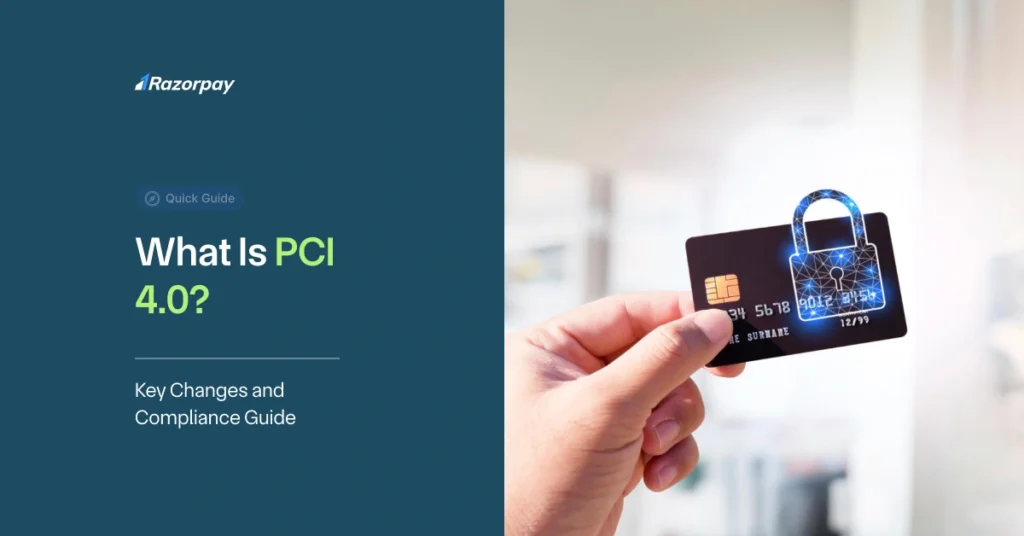The Payment Card Industry Data Security Standard (PCI DSS) has been a cornerstone of payment security since its introduction in 2006. Designed to protect cardholder data, it applies to any entity involved in payment processing, storing, or transmitting credit card information. On March 31, 2022, a major update, PCI DSS 4.0, was released to meet the demands of a rapidly evolving digital landscape.
With new cyber threats, modern technologies, and changing payment gateway infrastructures, PCI DSS 4.0 brings significant updates to help organizations maintain robust security controls. In this guide, we explore the key changes, timelines, and practical steps for achieving PCI DSS compliance under the latest version.
Table of Contents
What is PCI DSS 4.0?
PCI DSS 4.0 introduces a more flexible, modernized approach to compliance. It focuses on enabling organizations to tailor their security controls to their environments while still maintaining the same high bar of data protection required by earlier versions. The update also recognizes that a one-size-fits-all model may not suit today’s dynamic and distributed payment systems.
The changes made in PCI DSS v4.0 are not just iterative, they’re transformative. The goal is to ensure that companies can continuously monitor, adapt, and strengthen their controls in the face of evolving threats such as phishing attacks, e-skimming, and credential theft. These updates impact how companies, especially payment processors, merchants, service providers, and payment gateways, approach their ongoing compliance and PCI DSS certification efforts.
By aligning security standards with modern technologies and practices, PCI compliance 4.0 is a significant step forward in building trust across the payment processing ecosystem. Whether you’re a certified entity or pursuing certification for the first time, understanding the PCI DSS 4.0 requirements is crucial for safeguarding your systems and protecting customer data.
For a comprehensive overview of the compliance process, risk milestones, and practical steps to align with the new version, this guide will help you prepare for PCI DSS 4.0 adoption and beyond.
Updated Requirements in PCI DSS 4.0
PCI DSS 4.0 introduces a series of significant updates built around four key objectives: supporting evolving security needs, encouraging continuous compliance, offering increased flexibility, and improving validation methods. Here’s a breakdown of what’s new:
1. Customized Approach
One of the most notable changes in PCI DSS v4.0 is the introduction of a customized approach to meeting compliance requirements. Unlike traditional checklist-based compliance, this approach allows organizations to design and implement innovative, risk-based controls tailored to their specific environments. These are not compensating controls, but fully valid alternatives, as long as the intent of each requirement is met and properly documented. This shift provides greater flexibility for businesses using modern payment solutions and infrastructure.
2. Updated Authentication and Access Controls
The new version enforces mandatory multi-factor authentication (MFA) for all access to cardholder data, including both administrative and user-level interactions. Additionally, the minimum password length requirement has been increased from 8 to 12 characters to reduce the risk of brute-force attacks. Shared, group, and generic accounts are now more tightly regulated, with stricter policies on their use. Furthermore, the standard introduces clearer documentation of roles and responsibilities for each control, helping organizations ensure accountability within their PCI DSS compliance programs.
3. New Requirements to Combat Emerging Threats
To address modern security challenges such as phishing attacks, malware, and e-skimming, PCI DSS 4.0 includes several new requirements. Organizations must implement anti-phishing training for employees and deploy technical controls to block phishing attempts. For e-commerce platforms, enhanced monitoring mechanisms are required to detect unauthorized script injection and tampering. Additionally, logging requirements have been strengthened to provide more detailed access control records, improving threat detection and forensic readiness.
4. Enhanced Reporting Requirements
The documentation process has been revamped with new templates for the Self-Assessment Questionnaire (SAQ) and the Report on Compliance (RoC). These updated formats are designed to make assessments more transparent and consistent. Improved guidance is also provided for both assessors and internal audit teams, making it easier for organizations to navigate the compliance process and maintain payment security throughout the year.
When Did PCI DSS 4.0 Go into Effect?
Here’s the compliance timeline for PCI DSS 4.0:
- March 31, 2022: PCI DSS 4.0 was officially released.
- March 31, 2024: Transition period ends; PCI DSS 3.2.1 is now retired.
- March 31, 2025: Future-dated requirements become mandatory.
Organizations should now be aligning with PCI DSS 4.0 and preparing for full implementation by the 2025 deadline.
What Changes Does PCI DSS 4.0 Bring for Certified Organizations?
If your organization is already PCI DSS v3.2.1 certified, transitioning to PCI DSS 4.0 involves more than just ticking a few boxes. The new version emphasizes flexibility, continuous risk assessment, and stronger controls. Here’s how to prepare:
- Start by thoroughly reviewing the PCI DSS 4.0 framework to understand changes across all 12 core requirements.
- Conduct a detailed gap analysis to identify where your current controls do not meet the updated expectations.
- Partner with a Qualified Security Assessor (QSA) or use a trusted compliance platform to guide implementation and track progress.
- Ensure that internal teams receive role-specific training on revised password policies, MFA mandates, and documentation updates.
- Prepare early for future-dated requirements that will become mandatory by March 31, 2025, to stay ahead of compliance deadlines.
How PCI DSS 4.0 Impacts First-Time Certification Seekers
For businesses pursuing PCI DSS certification for the first time, version 4.0 introduces a more adaptive and outcome-based approach to cardholder data protection. Here’s how you can get started:
- Begin by identifying which PCI DSS compliance level applies to your business, based on your transaction volume and processing methods.
- Work closely with a compliance manager or QSA to understand your obligations and create a step-by-step roadmap.
- Use risk assessment tools to identify potential vulnerabilities in your systems and address them proactively.
- Automate key aspects of your compliance process, including reporting and control monitoring, to reduce manual errors.
- Choose payment solution providers and platforms that are already aligned with PCI DSS 4.0 to simplify compliance from the start.
The Six Key Milestones in PCI DSS 4.0 Compliance
The Prioritized Approach outlined by the PCI Security Standards Council breaks down the compliance journey into six logical milestones. These steps help organizations methodically strengthen their payment security posture while working toward full PCI DSS 4.0 compliance.
1. Protect Sensitive Authentication Data and Minimize Cardholder Data Retention
Organizations must identify all locations where sensitive authentication data (like CVV codes or PINs) is stored and ensure it is either securely protected or eliminated. Retention should only occur if absolutely necessary and must comply with defined retention limits.
2. Secure Systems and Prepare for Breaches
Robust system hardening and vulnerability management practices should be in place. This includes regularly updating software, applying patches, and having an incident response plan ready to quickly detect, contain, and respond to any security breaches.
3. Ensure Secure Payment Applications
All payment applications used to process cardholder data must follow secure development practices and be validated against PCI DSS requirements. Regular testing and updates are critical to reducing risk from outdated or vulnerable applications.
4. Monitor and Control Access to Systems
Access to cardholder data and related systems should be restricted based on job roles. Organizations must implement multi-factor authentication (MFA), ensure unique IDs for each user, and maintain logs to monitor access attempts and detect anomalies.
5. Protect Stored Cardholder Data
Any cardholder data that must be stored must be encrypted using strong cryptographic methods. Organizations should also implement key management processes to safeguard encryption keys and restrict access to stored data.
6. Finalize Compliance Gaps and Validate Controls
The last step involves addressing any outstanding requirements from earlier milestones. This includes validating controls, completing necessary documentation, and preparing for formal assessments such as the Report on Compliance (RoC) or the Self-Assessment Questionnaire (SAQ).
New PCI DSS 4.0 Requirements for All Entities
PCI DSS 4.0 introduces immediate requirements that apply to all entities processing, storing, or transmitting cardholder data. These updates enhance security practices to address modern threats and technology environments.
Requirement 1: Install and Maintain Network Security Controls
Organizations must implement network security controls that protect all system components, including traditional firewalls as well as cloud-based and virtualized environments. This ensures comprehensive traffic filtering and monitoring across complex infrastructure setups.
Requirement 2: Apply Secure Configurations to All System Components
All systems must be configured securely using industry best practices. This involves disabling unnecessary ports and services, removing default credentials, and maintaining clear documentation of configurations to prevent exploitation.
Requirement 3: Protect Stored Account Data
Stronger encryption methods must be used to protect stored cardholder data. Organizations also need to enforce strict data retention policies, ensuring that sensitive data is retained only as long as necessary and properly deleted afterward.
Requirement 4: Protect Cardholder Data in Transmission
Cardholder data transmitted over public or untrusted networks must be encrypted using strong cryptographic protocols like TLS 1.2 or higher. Weak encryption standards must be phased out to protect against interception and eavesdropping.
Requirement 5: Protect Systems Against Malware
Entities are required to deploy anti-malware solutions on all systems vulnerable to malware infection. Regular malware risk assessments and continuous monitoring are necessary to detect and prevent malware attacks effectively.
Future-Dated PCI DSS 4.0 Requirements (Effective March 2025)
Some PCI DSS 4.0 requirements have a future compliance deadline of March 31, 2025. These allow organizations time to adapt their security posture while encouraging early adoption of enhanced controls.
Enhanced Multi-Factor Authentication (MFA)
From March 2025, MFA will be required for all access into the cardholder data environment (CDE), including administrators and non-console access. Organizations should start implementing MFA broadly to ensure a smooth transition.
Expanded Role-Based Access Controls
Organizations will need to implement more granular access controls, assigning specific permissions based on clearly defined roles and responsibilities. This limits access to only the necessary data and systems, reducing insider risk.
Increased Logging and Monitoring Requirements
PCI DSS 4.0 mandates enhanced logging of all access to critical systems and sensitive data. Businesses should invest in centralized logging and real-time monitoring tools to identify suspicious activities promptly.
Risk-Based Authentication Flexibility
While MFA is mandated, PCI DSS 4.0 allows organizations to use a risk-based authentication approach where appropriate. This gives entities flexibility to tailor controls to their environment but requires robust risk assessments and documentation.
Interim best practice: Start reviewing current authentication and access policies now and invest in training teams on new requirements to meet the 2025 deadline confidently.
PCI DSS 4.0 for Service Providers: New Requirements
Service providers face additional responsibilities under PCI DSS 4.0 due to their role in managing sensitive payment data for multiple clients.
Expanded Compliance Scope
Service providers must comply with more stringent security controls, reflecting the greater risk associated with handling data for diverse organizations. This includes detailed documentation and validation of controls specific to outsourced environments.
Clear Role and Responsibility Definitions
PCI DSS 4.0 requires service providers to clearly define and communicate roles and responsibilities for securing cardholder data, both internally and in client interactions. Accountability must be established across all levels of service delivery.
Enhanced Monitoring and Incident Response
Service providers must implement robust monitoring, logging, and incident response mechanisms. This ensures rapid detection and mitigation of security incidents that could impact multiple client environments.
Regular Independent Assessments
Service providers are expected to undergo more frequent and detailed assessments by Qualified Security Assessors (QSAs) or internal audit teams. They should maintain comprehensive evidence of compliance to build client trust and meet regulatory expectations.
These specific new requirements emphasize the critical role of service providers in safeguarding payment data and supporting the overall PCI DSS ecosystem.
How to Prepare for PCI DSS 4.0: Steps and Best Practices
Preparing for PCI DSS 4.0 requires a proactive, organized approach to ensure your organization remains compliant and secure. Follow these essential steps and best practices:
Conduct a Comprehensive Internal Assessment
Begin by reviewing your current PCI DSS 3.2.1 compliance status. Identify gaps related to the new 4.0 requirements, especially around multi-factor authentication, encryption, and logging.
Engage Qualified Security Assessors (QSAs)
Collaborate with experienced QSAs or use trusted compliance platforms to interpret the new standards and guide your remediation efforts effectively.
Update Security Policies and Procedures
Revise your internal policies to reflect the customized, risk-based approach encouraged by PCI DSS 4.0. Make sure documentation is clear, up-to-date, and accessible to all relevant teams.
Train Your Teams Thoroughly
Provide training sessions for IT, security, compliance, and operations teams. Ensure everyone understands the new requirements, their specific roles, and how to maintain documentation and controls.
Implement or Upgrade Technology Solutions
Invest in technologies that support enhanced encryption, robust access controls, and continuous monitoring. Consider automation tools for logging, vulnerability scanning, and compliance reporting.
Test and Monitor Continuously
Establish ongoing testing procedures for your security controls and monitoring systems. Continuous vigilance is key to identifying risks early and maintaining compliance.
By following these steps, organizations can confidently align with PCI DSS 4.0 and protect their payment environments from evolving cyber threats.
Conclusion
Adopting PCI DSS 4.0 is crucial for organizations handling cardholder data, as it strengthens defenses against today’s sophisticated cyber threats. Ensuring compliance not only protects your business from costly breaches and penalties but also safeguards your customers’ sensitive information. Staying updated with PCI DSS standards demonstrates your commitment to security, builds trust in your brand, and supports a safer payment ecosystem. By preparing early and embracing the flexible, risk-based approach of PCI DSS 4.0, your organization can confidently navigate the evolving landscape of payment security.
Frequently Asked Questions
1. How is PCI DSS 4.0 different from PCI DSS 3.2.1?
PCI DSS 4.0 introduces a more flexible, risk-based approach to security, allowing organizations to customize controls while meeting the intent of each requirement. It also includes updated authentication rules, enhanced encryption standards, and stronger monitoring requirements to address modern threats more effectively.
2. Who needs to comply with PCI DSS 4.0?
Any organization that processes, stores, or transmits payment cardholder data must comply with PCI DSS 4.0. This includes merchants, service providers, and payment processors of all sizes.
3. What are the key deadlines for PCI DSS 4.0 compliance?
PCI DSS 4.0 was released on March 31, 2022. Immediate requirements are already in effect, while future-dated requirements become mandatory on March 31, 2025. Organizations should prepare early to ensure full compliance by these deadlines.
4. Does PCI DSS 4.0 apply to small businesses?
Yes, PCI DSS 4.0 applies to businesses of all sizes that handle cardholder data. The requirements scale depending on the organization’s transaction volume and risk level, but all must meet the core security standards.
5. Do I need to be PCI DSS certified if I use a payment gateway?
Even if you use a third-party payment gateway, your business may still be required to comply with PCI DSS. Certification requirements depend on your role in handling card data and your transaction volume, so it’s important to assess your responsibilities carefully.


